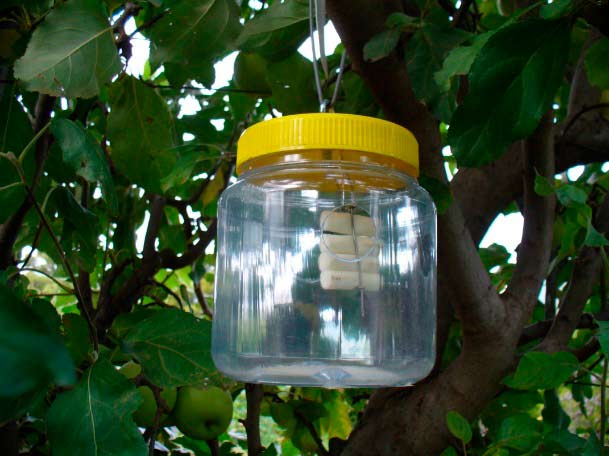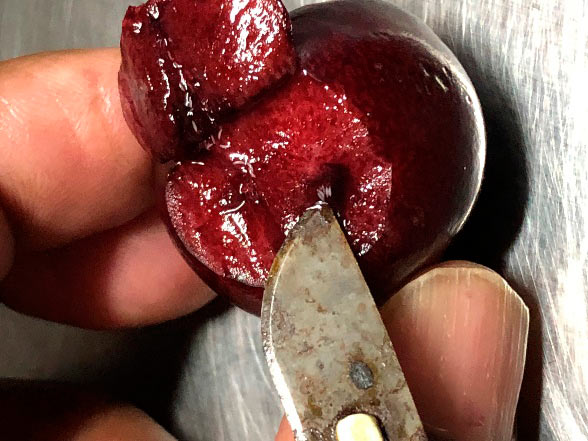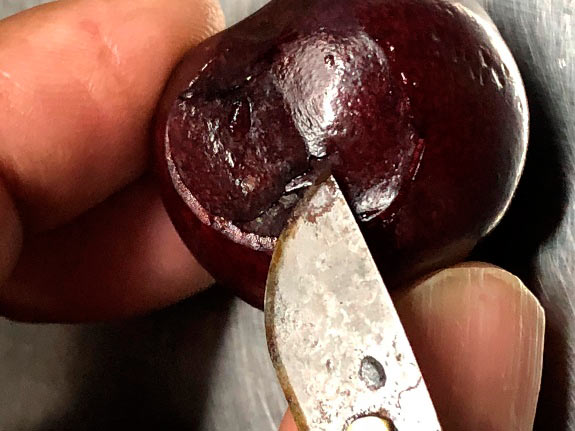By B. Koll, Queensland Fruit Fly Regional Coordinator (Yarra Valley)
The important actions for controlling or preventing Queensland Fruit Fly include orchard hygiene, monitoring, mass trapping, baiting and cover sprays (only if required).
What is monitoring? Monitoring refers to the deployment of fruit fly traps, and their regular inspection. Monitoring must also include a physical inspection of the fruit, in case the flies have avoided the traps. Monitoring in and around the orchard needs to start earlier than the likely pest activity period. There will always be the early movers in a pest population, just like there will be a part of the population that moves late. Early detection can trigger an early response!
Monitoring can be used to prove pest absence – in the case of a region or property trading their fruit to a QFF sensitive market. Monitoring can also be used in a known fruit fly area to provide information on the fruit fly population trends. Regular inspection data forms an indication of what the fly population is doing (rising or falling) and determines what action happens on the orchards next.
So what traps do I use? There are different types and different brands of fruit fly traps.
1. Male lure traps
2. Food lure (protein) traps
3. Female biased (fruit scented) traps
 Male lure traps use a chemical scent that attracts the male fruit flies. Some male lure traps use a dry method, where the attractant and insecticide are soaked onto a wick or similar. When the fly touches the insecticide component, he dies. The lures require replacement after about 3 months. This dry method is favoured for monitoring over using a wet type trap. A Lynfield trap is the version of fruit fly trap used when performing monitoring tasks according to the Queensland Fruit Fly Code of Practice.
Male lure traps use a chemical scent that attracts the male fruit flies. Some male lure traps use a dry method, where the attractant and insecticide are soaked onto a wick or similar. When the fly touches the insecticide component, he dies. The lures require replacement after about 3 months. This dry method is favoured for monitoring over using a wet type trap. A Lynfield trap is the version of fruit fly trap used when performing monitoring tasks according to the Queensland Fruit Fly Code of Practice.
A wet “male lure” trap uses a male attractant in a body of fluid, drowning the fly when he lands on the fluid surface. Wet traps require regular refilling – particularly after a hot dry period, and can often require tools like sieves and paper towel to assist in the inspection process.
Protein based traps are designed to lure flies in with an easy source of food (protein), attracting male and female. Protein is required by the juvenile fly to reach adulthood - sexual maturity. Females are very also dependant on proteins as a food source because of their protein requirement for egg production. Protein traps can be in the form of a wet trap (i.e. in a liquid to drown the fly) or in the form of a gel used in combination with an insecticide component. Wet traps require refilling, additional inspection time and tools (as above). The gel requires replacement every three months.
Ripening fruit scents are the basis of another style of fruit fly traps. The gravid (pregnant) females are attracted to ripening fruit scents and colours in order to lay their eggs, thus the traps are female biased. These traps use a sticky surface to capture the fruit flies. These styles of traps require replacement every 8 weeks.
All of the above styles of traps have a specific demographic target in the fruit fly population. It is vital to use a variety of trap styles to improve the clarity one has of the fruit fly population picture in an orchard system. Trapping of flies can have an impact on overall fly population if a high number of traps are used per hectare. It is important to note that all the traps have limitations and are only a part of the overall fruit fly war-chest, along with hygiene, baiting and cover sprays (only if required).
The traps are competing against naturally occurring male attractants, proteins and of course ripe fruit in the natural landscape. Flies are more naturally attuned to seeking these in a rainforest, or bush setting, such as from a leaf or fruit surface, as opposed to ‘in traps’. Trap efficacy is dependant on the timing of trap deployment- compared to the fruit crop ripening, the activity of the fruit fly population, the season’s weather patterns, the location and rate of traps/ha, and the competing interests and scents in the local area. This is why trap data is best used as a guide to indicate fruit fly population trends, and why trapping is only part of the overall fruit fly control program.


The importance of physical fruit monitoring cannot be overlooked, in case the flies have missed the traps. Inspecting fruit for new or fresh fruit fly damage it is difficult to do, and requires experience and definitely at least a hand lens. Here’s a cherry infested with Queensland fruit fly, showing only a slight indication of damage on the outside, and the eggs present just under the surface. A trained eye can pick the damage; however, it is recommended to slice the fruit thinly to investigate with greater confidence. These photos were taken at a recent cherry growers fruit fly information event hosted by NSW DPI and Applied Horticultural Research.
Fruit fly prevention and control requires good orchard hygiene; including other managing non-commercial fruit hosts, continued management of fruit left after the main harvest, control of what fruit enters the property, and correct disposal of infested fruit. A management program will also involve monitoring, mass trapping, protein bait application, and maybe cover sprays (with caution and only when necessary). Fruit fly control requires an area wide management approach involving encouraging cooperative neighbours to also assist in the fight against the Queensland fruit fly.
Good luck with the trapping component of your Queensland fruit fly control program – and remember to share your trapping results with others in your community for the best area wide outcome in fruit fly control.
(Download this article below)
and return it to: VCA Secretary, PO Box 612, Mooroopna, 3629
Web design by Fruit Tree Media